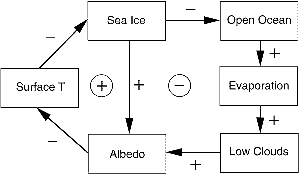7.5.2 Sea Ice
|

Figure 7.6: Idealised feedback loops involving sea ice. The
signs attached to the arrows indicate the correlation between changes
in the quantity of the outgoing box with that of the ingoing box, e.g.,
more sea ice leads to larger albedo. Resulting correlations of a loop
are circled and they indicate whether a process is self-reinforced (positive
sign) or damped (negative sign). Generally, resulting negative correlations
can lead to oscillations, whereas resulting positive correlations may
lead to instabilities. The classical ice-albedo effect is shown in the
left loop, a feedback involving the overlying atmosphere is on the right.
|
Sea ice plays an important role in moderating heat exchange
between the ocean and atmosphere at high latitudes, especially by controlling
the heat flux through openings in the ice. Sea ice also interacts with the broader
climate system via the ice albedo feedback, which amplifies projected climate
warming at high latitudes, and by oceanic feedbacks involving ice growth and
melt and the fresh water balance at the ocean surface (Curry and Webster, 1999;
Lewis, 2000) Two feedbacks associated with sea ice are illustrated in Figure
7.6.
The Arctic Ocean sea-ice cover evolves from a highly reflective snow covered
surface with few openings in May to a decaying sea-ice cover, mottled with melt
ponds and interrupted by frequent openings in July. The seasonal changes in
mean albedo in the central Arctic, from roughly 0.8 in May to 0.5 in mid-August,
are known to within about ± 0.06 to 0.08. The mean spatial pattern in
each summer month features lower albedos in the central Arctic and values 0.1
to 0.2 higher along the ice margins, but the spatial evolution of the pattern
in any given year is variable. Averages observed at Soviet North Pole drifting
stations, from 1950 to 1991, tend to be higher than satellite-based estimates
(Marshunova and Mishin, 1994). Albedo depends on wavelength of radiation and
on type and thickness of ice; however, ice type and thickness become unimportant
if the snow cover exceeds 3 cm water equivalent. The representation of sea-ice
albedo in AGCMs may take account of fractional snow cover, specified or predicted
sea-ice thickness, ice surface temperature and the fraction of openings and
puddles (Barry, 1996). Most models treat visible and near-infrared spectral
ranges but there is still a wide variety of snow and ice albedo parametrizations
among atmospheric and ocean GCMs. Important new data sets on puddle albedos
(Morassutti and LeDrew, 1996) and the temporal evolution of melt pond coverage
(Fetterer and Untersteiner, 1998) will enable more realistic albedo formulations
to be developed.
Since the SAR, several coupled climate models have incorporated an explicit
treatment of openings in sea ice, often in conjunction with ice dynamics. This
is typically effected by partitioning a model grid cell into ice-free and ice-covered
fractions. However, sub-grid scale variability in ice thickness, not represented
in these schemes, can have a potentially important influence on sea-ice mass
balance (Schramm et al., 1997), ice/ocean fluxes of heat and fresh water (Holland
et al., 1997b) and the sensitivity of sea ice to thermodynamic perturbations
(Holland and Curry, 1999). Recent advances in modelling the thickness distribution
function make representing sub-grid scale variability, and the accompanying
effects, feasible in global climate simulations (Bitz et al., 2001). Other developments
since the SAR include updated parametrizations of snow ageing and associated
albedo changes and the implementation in some models of a multi-layer formulation
of heat conduction through the ice. Snow plays a particularly important role
in sea-ice thermodynamics by modifying the surface albedo, reducing thermal
conductivity (and hence ice growth rates), and in some locations causing submergence
and surface flooding of ice. Considerable effort continues to be devoted to
the development and testing of improved physically based parametrizations suitable
for use in such models. Recent field experiments, most notably SHEBA (Randall
et al., 1998; Perovich et al., 1999), have provided observational data particularly
suited to evaluating climate model parametrizations of sea-ice thermodynamic
processes and initial attempts at this are underway. Although sea-ice thermodynamic
processes are crudely approximated in many coupled climate models (see Chapter
8, Section 8.5.3), it is unclear how these approximations
contribute to errors in climate model simulations.
Ice motion is driven by wind and ocean currents and resisted by ice-ocean
drag and internal ice stresses. The representation of internal stresses is the
primary distinguishing feature among ice dynamics models. Sensitivity experiments
with stand alone sea-ice models (Hibler, 1984; Pollard and Thompson, 1994; Arbetter
et al., 1997) indicate that inclusion of ice dynamics can alter the modelled
sensitivity of the ice cover to climatic perturbations. An assessment of sea-ice
dynamic schemes suited to use in global climate models has been undertaken by
the ACSYS Sea-Ice Model Intercomparison Project (SIMIP) (Lemke et al., 1997),
which has initially focused on the evaluation of sea-ice rheologies (the relationship
between internal stresses and deformation). Results are summarised in Kreyscher
et al. (1997) and indicate that the elliptical yield curve, viscous-plastic
scheme of Hibler (1979) generally outperforms the other schemes evaluated in
terms of comparisons to observed ice drift statistics, ice thickness and Fram
Strait outflow. Clearly, the effects of ice-related fresh water transports and
of other potentially important processes influenced by ice dynamics are not
included in climate models which ignore ice motion (see Chapter
8, Section 8.5.3). The effect on climate sensitivity
remains to be assessed. Since the SAR, progress has been made at improving the
efficiency of numerical sea-ice dynamic models, making them more attractive
for use in coupled climate models (Hunke and Dukowicz, 1997; Zhang and Hibler,
1997).
Continues on next page
